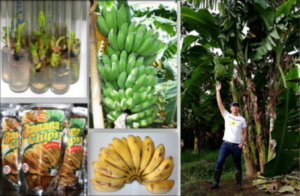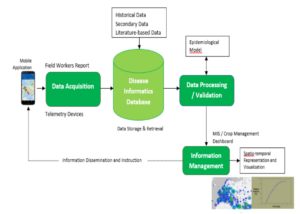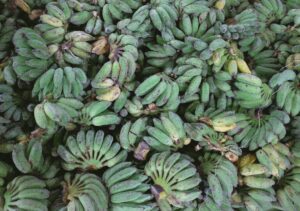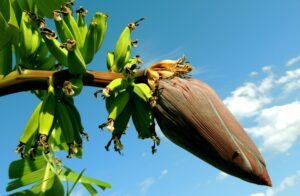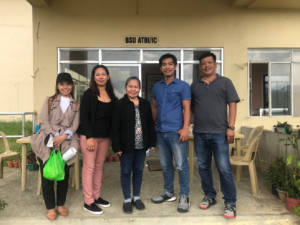
Banana Industry Profile
Banana, with its many potential health benefits, is one of the most important fruit crops in the Philippines. The Philippine Banana Industry comprises farmers, cooperatives, traders, exporters, and manufacturers but is mainly dominated by large multinational companies. There are three major varieties produced in the country: 1. Cavendish, the primary variety (50% of the total banana production), generates 329,648 jobs in the country, providing P42.3B in annual wages; 2. Lakatan, a popularly known dessert, contributes 11% of the total banana production; and 3. Saba, a major cooking-type banana, comprises 29% of the total banana production. The Philippines is the 3rd largest producer of bananas globally, following India and China in 2014 (FAOStat, 2017). Based on data from the Philippine Statistics Authority (PSA), as of 2019, the Davao region is the top producer of bananas with 3.43M mt or 37.4% of the total banana production in 2019. Significant banana producers in the Philippines also include the regions of Northern Mindanao, SOCCSKSARGEN, and BARMM, with 21.4, 12.9, and 6.5 percent shares in 2019 production, respectively.
Banana products are commonly exported fresh and processed like banana chips, one of the emerging export winners of the Philippines. The raw materials for banana chips production are based on two cultivars, namely Saba and Cardaba.
Problems in the Industry
The industry’s major problem is its susceptibility to major diseases such as banana bunchy top disease (BBTD), Sigatoka, and Fusarium wilt (FW), also known as Panama disease. Cavendish was threatened by Fusarium wilt (FW) tropical race 4, a disease caused by a soil-borne pathogen, Fusarium oxysporum f. sp. cubense (Foc). FW could thrive in the soil for years, causing banana plants to wilt and make the plantation unproductive. BBTD, on the other hand, is a major constraint and is considered the most destructive virus disease of bananas in the country. It severely affects the Lakatan variety, which is commonly grown by small-scale growers. The industry further faced a lack of supply, particularly in the banana chips industry, mainly due to traditional Saba taking several months (18-24 months) before it can be harvested.

- Price
- Production
- Policies and Programs
- Farm Gate Price
- Retail Price
- Wholesale Price
- Volume
- Value
- Area
- Yield
Data Source: Philippine Statistics Authority. 1990-2022.
Notes:
- Volume of production of banana in metric tons (MT)
- Area of production of banana in hectares (ha)
- Yield of banana production in metric tons (MT)
- Utilization of banana in thousand metric tons
- Utilization of banana per capita in thousand metric tons
- Value of Production at Current Prices in Million PhP
- Value of Production at Constant 2018 Prices in Million PhP
- Gross Value Added at Constant 2018 Prices in Million PhP
- Gross Value Added at Current Prices in Million PhP
- Farmgate price of banana in Pesos per kilogram
- Retail Price of Banana in Pesos per kilogram
ISP for Banana
PCAARRD ISP on banana aims to reduce the incidence of FW on Cavendish in Mindanao by 90-95% and the banana bunchy top virus (BBTV) in Lakatan from 70% to 20%. It also aims to develop a dwarf Saba which can be harvested earlier at 12-18 months compared with the traditional Saba at 18-24 months.
Strategic R&D
Strategic R&D is DOST-PCAARRD’s banner program comprising all R&D activities that are intended to
generate outputs geared towards maximum economic and social benefits
Multi-location Evaluation of Promising Saba Strains with Short Stature
The Philippine banana chips industry has become one of the country’s emerging export winners. The raw materials for banana chips...
Read MoreBanana productivity and supply chain enhancement in Cagayan Valley Region
Focusing on Saba, Lakatan, and Latundan varieties, the program was proposed to sustain the banana industry in Cagayan. The program...
Read MoreNanobiopesticide for Fusarium wilt control
With the aim to develop a nanobiopesticide using metabolite/s from plant growth-promoting bacteria (PGPB) against fusarium wilt on high-value crops,...
Read MoreTechnologies
Products, equipment, and protocols or process innovations developed to improve productivity, efficiency,
quality, and profitability in the agriculture and aquatic industries, and to achieve sustainable
utilization and management of natural resources
Banana Diseases Surveillance System
The development of mobile technologies for agricultural disease surveillance has not been the top priority in the Philippines. This is probably so because mobile agricultural service delivery is still at...
Read MoreTechnology Transfer Initiatives
Technology transfer initiatives ensure that the outputs of R&D and innovations are transformed
into viable and applicable technologies that help intended users
Pinoy S&T Services for Farmers and Entrepreneurs Program (PSF): Magsasaka Siyentista-Led Community Based Banana (Saba/Cardaba) Farming System In Davao Oriental
This project aims to rehabilitate using S&T-based approaches to the banana-cardaba production areas in the Typhoon Pablo affected municipalities in Davao Oriental. The proposed project sites will be located in...
Read MorePinoy S&T Services for Farmers and Entrepreneurs Program (PSF): Magsasaka Siyentista-Led Community Based Coconut And Banana Production Systems In Compostela Valley Province
This project will promote the coconut and banana intercropping systems in Monkayo and Nabunturan in Compostela Valley province through the Magsasaka Siyentista (MS) approach. One MS from each of the...
Read MorePinoy S&T Services for Farmers and Entrepreneurs Program (PSF): Magsasaka Siyentista-Led Community-Based Coconut And Banana Farming Systems In Davao Del Norte
This project aims to promote the Integrated Crop Management and Good Agricultural Practices in banana and coconut farming system in Typhoon Pablo-affected municipalities of Davao del Norte through the Magsasaka-Siyentista-led...
Read MoreCoconut-Based Intercropping with Banana and Corn as Livelihood Options for Communities in Brgy. Camansihay, Tacloban, Leyte: An S&T Community-Based Farm (STCBF) Approach
The proposed project will try to demonstrate the effectiveness and benefits of the technologies on improving farm productivity through organic farming in Yolanda-affected communities, particularly in one barangay of Tacloban...
Read MoreIFSU IP-TBM Phase II: Patent Mining of Banana Towards a Sustainable Ifugao State University Intellectual Property and Technology Business Management Office (IFSU IPTBM)
The ongoing project enhances and strengthens the capacities of IP-TBM offices through Patent landscaping and mining. It involves the following activities: Capacitation of the IP-TBM personnel of IFSU in Patent...
Read MoreCapacity Building
Capacity building efforts of DOST-PCAARRD seek to develop and enhance the R&D capabilities of researchers
and academic or research institutions through graduate assistantships & non-degree trainings
and development and/or upgrading of research facilities
Infrastructure Development
Manpower Development
Capacity building on Banana production, disease management and introduction of Lakatan cultivar
Policy Research & Advocacy
Analysis of policy concerns and advocacy of science-informed policies ensures that the AANR policy environment is conducive for S&T development
and investments
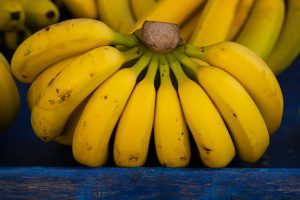
Competitiveness of Philippine Cavendish Industry under the ASEAN Economic Community
The study shows that banana production in the country is competitive under both export trade and import substitution scenarios. This implies that Philippine banana is competitive internationally and exporting it can help earn foreign exchange. The cost of producing these domestically is also much cheaper relative to imports. Results also show that the Philippine banana industry can still be competitive even if yield (52.62 mt/ha) goes down by 58 percent, or domestic and foreign cost rise by 210 and 426 percent, respectively. Sustaining this competitiveness would require continuous investment in banana R&D, especially that the industry is still facing major challenges.
Reference:
Lapiña, G. F. and Andal, E. T. (2017). ASEAN Economic Community: Opportunities and Challenges for the Crops Sector. Los Baños, Laguna, Philippines: Philippine Council for Agriculture, Aquatic and Natural Resources Research and Development – (Project Report)

